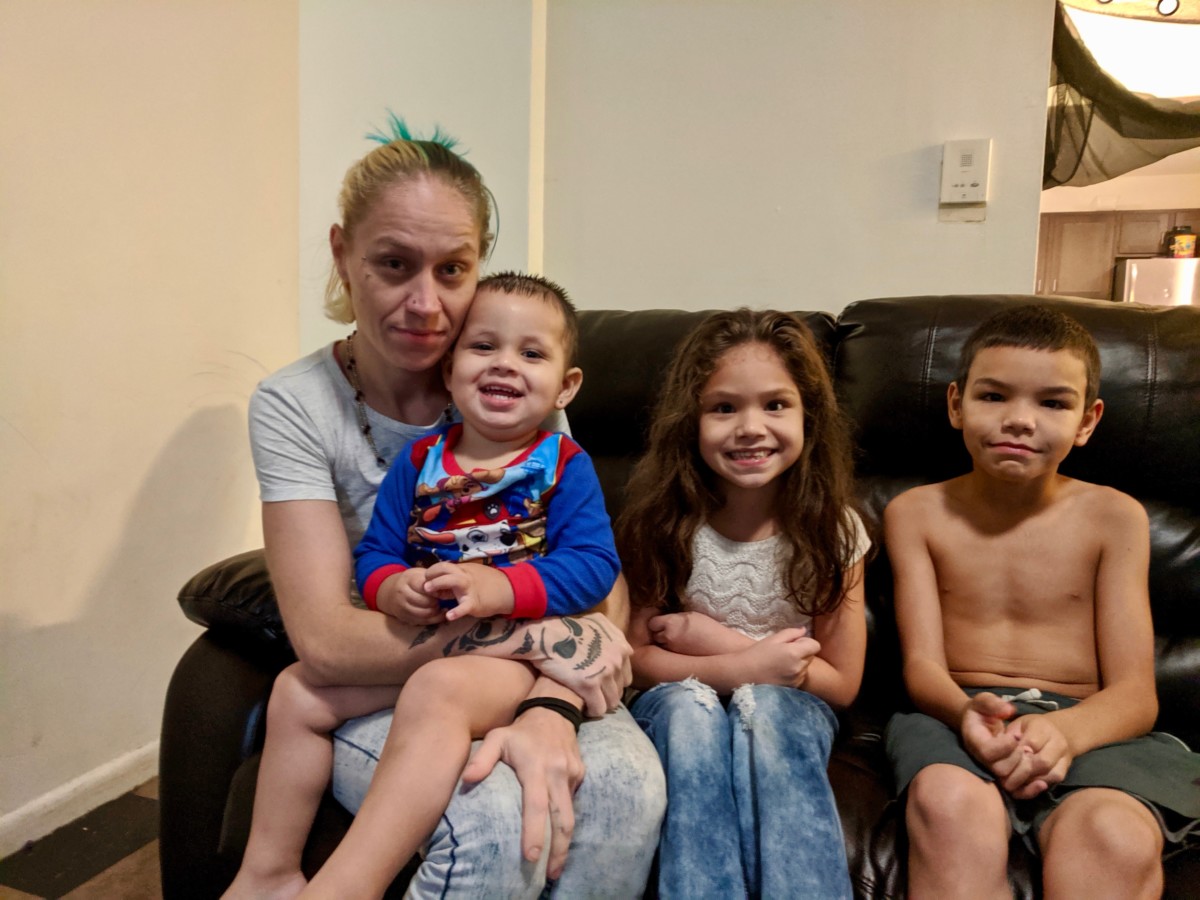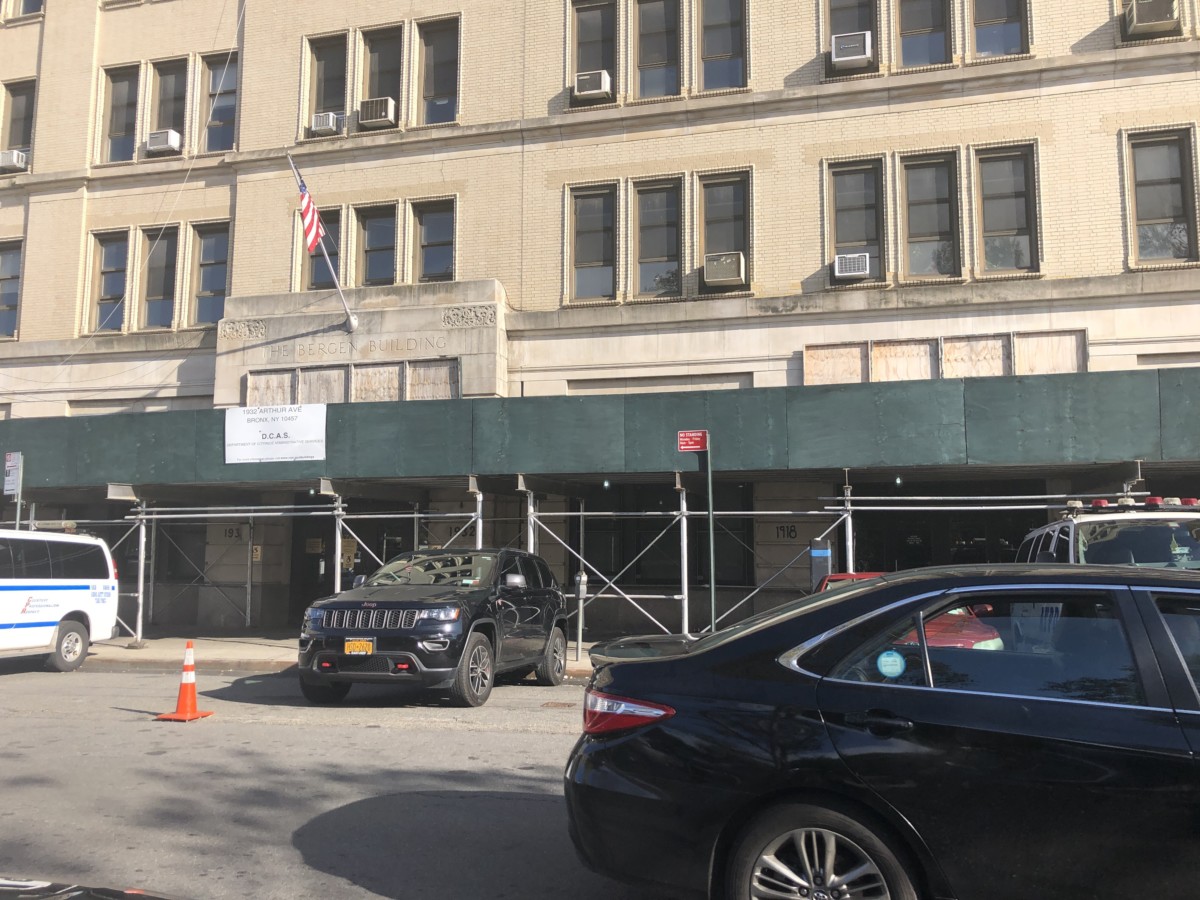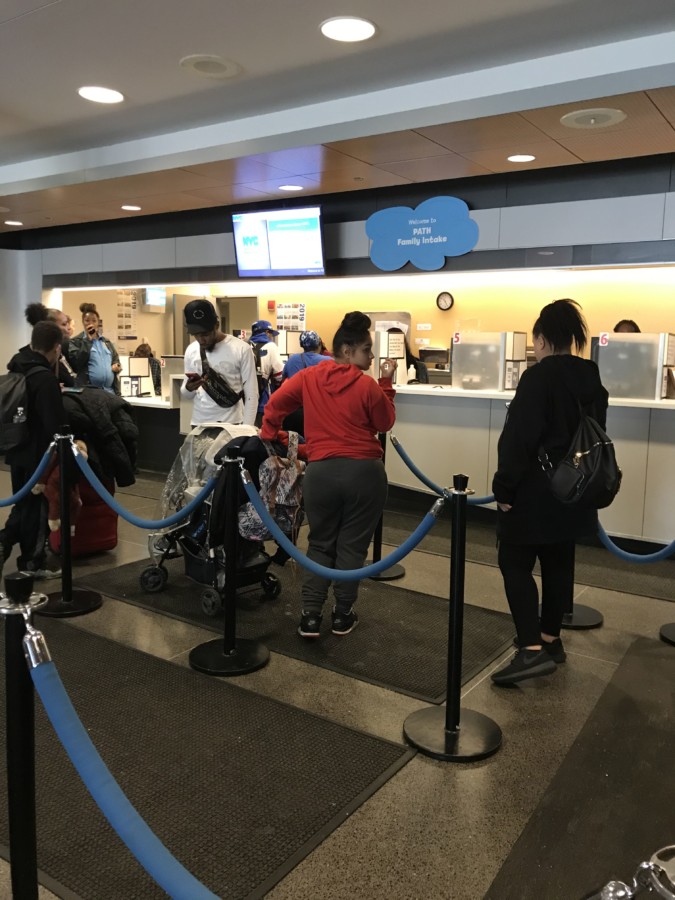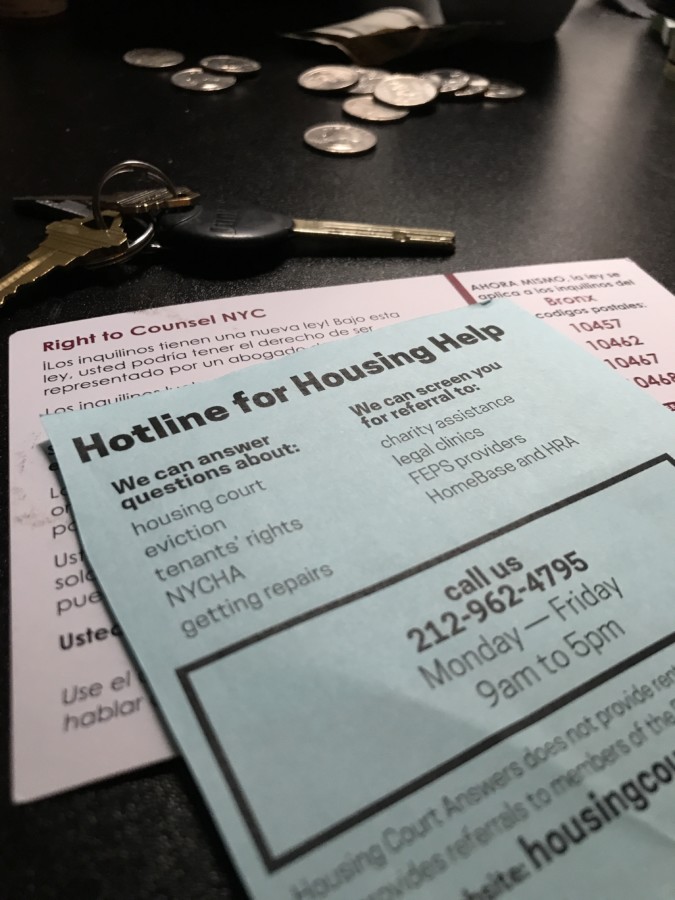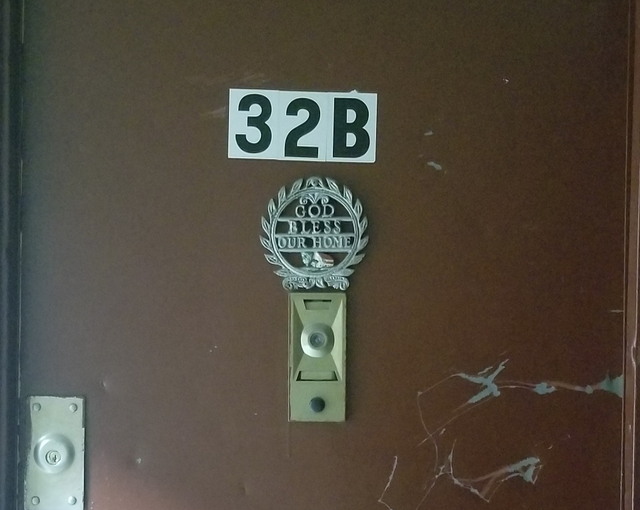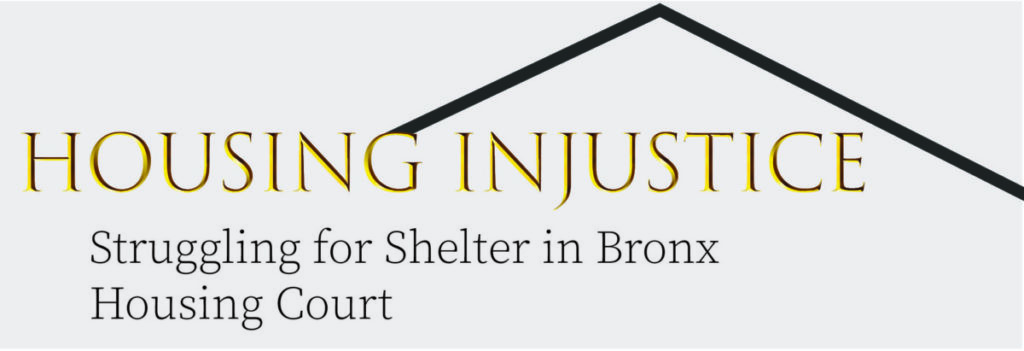
_______________________________________________
By: Ian Karbal
By 7:30 a.m., the line had already formed outside 1118 Grand Concourse. By the time the doors to the courthouse opened, the line would exceed 100 people. Hugging the walls of buildings, it snaked down the sidewalk. Some were scared, some angry, and others all too familiar with the bureaucratic labyrinth awaiting them just past the guarded set of double doors.
For most, their time in Bronx Housing Court would determine whether they’ll have a home to go back to when they leave.
By 8:00, the line stretched down the Concourse, past a cottage industry of sorts that had sprung up to serve the captive clientele. A strategically parked food cart did a swift business in empanadas deep fried on the spot. Another man handed out flyers for a moving company, offering free storage to those facing eviction. Growing still, the line overtook the entrance to the Bronx Works headquarters, where tenants like Madeline Legrand, 54, near the front of the line, had gone for rent assistance from HomeBase services for those trying to avoid becoming homeless.
It was 8:30 when LeGrand and the other early arrivals were finally let in to the most crowded housing court in all five boroughs. On one Tuesday in October, nearly 600 cases would be heard before the end of day by a dozen judges–a lighter load than usual. Most were in the throes of eviction, arriving on their own, without a lawyer, to navigate the tangled web of paperwork and legalese where the cost of a misstep could be their most basic need: shelter.
Most tenants are not represented by a lawyer. Most landlords are. Even the physical space of the court ⎯ overcrowded and sometimes standing room only ⎯ is intimidating.
Last year, 82,839 cases were filed in Bronx housing court. Of those, 95% were brought by landlords against their tenants, according to data from the Office of Court Administration.
This year, two new laws have begun to make a dent in the flood of landlord-initiated cases. Right to Counsel laws, and a more expansive renter protection law, went into effect in June of this year.

So far, the volume of housing court cases is down to 43,150, a drop of roughly 30% with three months left in the year.
“It’s hell in there. It’s too crazy,” said Legrand. “It makes you want to leave New York, but I got kids here.”
Legrand was dealing with her second non-payment case in as many years, meaning her landlord was demanding back rent. She receives disability supplements and sometimes receives assistance from the HomeBase program run through Bronx Works.
Legrand was one of the first in line that day because she has learned to show up early to ensure she gets representation from Legal Aid attorneys. Legal Aid’s housing court office can only take seven cases a day out of hundreds because of its limited resources.

After passing through security, the long line wound its way through the lobby only to form again in front of the clerks, the closest employees the court has to a gatekeepers. A clerk’s day is spent answering questions from confused tenants, since many have only just received notice to appear on a postcard.
Signs for programs that could help families avoid eviction through rent assistance get lost behind the throngs. And even if someone were to notice and enroll in the programs, systemic issues can wind the tenants back in housing court.
“I’ve seen it all,” said Kecia Ettienne, an associate housing clerk, through the slotted window behind her desk. “Upset, sad, angry. You just have to be calm. Everybody takes it differently.”
Above the clerk’s office are four floors of 13 courtrooms, where scratchings on the backs of some of the court benches serve as a record of the countless tenants who have sat there before. One carving, in fact, just says the word “record.” Another is an illustration of what looks like a Christmas tree, another, the “F” word.
On the top floor, up five rows of stairs, is the one courtroom where tenants still bring cases against their landlords concerning heating and hot water issues, vermin infestations, or crumbling ceilings. Ironically, this is the reason housing court was created, to give tenants a place to hold their landlords accountable for violating the city’s housing code.
A single courtroom can have as many as 80 cases a day. The cases begin as petitions which are sometimes dropped off en masse in cardboard boxes by landlords’ law firms.
Then postcards are sent out to tenants with a notice to appear in court, or a marshal is called to post a notice of eviction.
“You know 99% of tenants were unrepresented and 99% of landlords are represented,” said Jenny Laurie, director of Housing Court Answers, a non-profit advocacy group that operates in housing courts in all five boroughs.
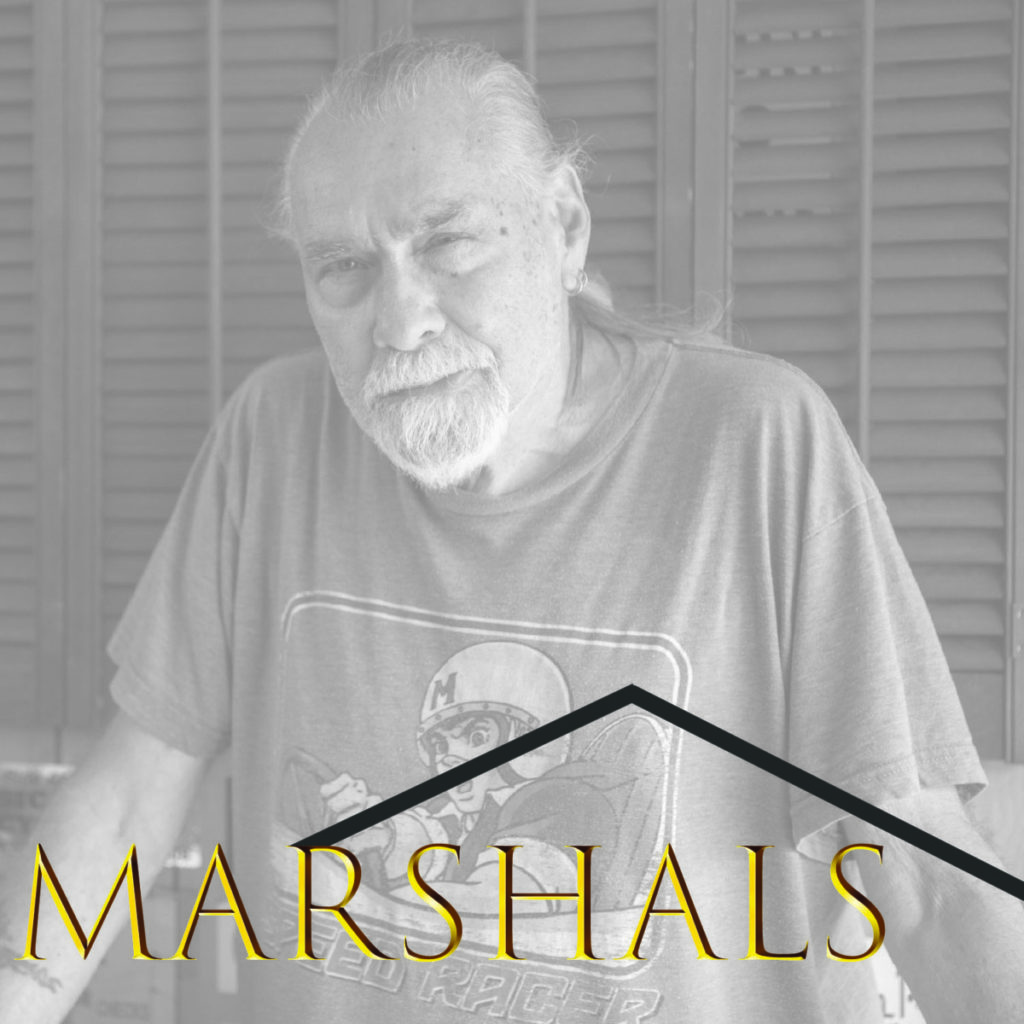
“And then on the reverse of that,” Laurie said, “even though housing court was created as a code enforcement venue, it really doesn’t do a very good job at that.”
Few cases end up in an actual trial. The courtrooms largely serve as a place where tenants and landlords can conference with a judge, whose role is something like that of a referee.
Outside every courtroom, tenants, landlords, and their lawyers fight for space. The benches fill up fast and the rest is standing room only. Parties pore over legal documents at the counters next to the stairs, sometimes elbow to elbow, sometimes huddled with lawyers, advocates or family members. Attorneys expertly navigate the crowd, bouncing back and forth between as many as 45 cases in a day.
This is where the real action happens, in full view of everyone waiting to be called into the courtroom, or in front of those gathering their wits to process whatever just happened inside. Few cases make it to trial.
Most disputes are settled in this hallway through agreements or “stips,” short for stipulations, legally binding paper agreements made between the parties and signed off by a judge.
When a case does make it to trial, it can be after months of adjournments and failures to reach an agreement. Mark Cohen, a lawyer who represents landlords, said,“Every trial is pro-tenant. If you do a ‘T’ instead of an ‘I,’ they say, ‘oh, this is defective. You gotta start over.’”
A case that doesn’t end quickly in a settlement can drag on for months, often with a landlord receiving no rent and having no grounds to evict the tenant.
“A lot of tenants who are taken to housing court don’t have an attorney and are facing their landlord who does,” said Laurie. “A lot of them just agree to a settlement that is really stacked against them and basically threatens them with eviction. Represented tenants don’t get into those binds in the same way.”
A second type of conference is held in the private hallways behind the courtrooms by a judge-appointed attorney between parties that are having trouble reaching an agreement. The sounds of raised voices sometimes spill out to the benches in the courtrooms.
_______________________________________________
A History of Injustice
_______________________________________________
According to Laurie, the housing court system was born out of the civil rights movement, when tenants’ rights activists largely in neglected communities of color, sought a way to hold slumlords accountable for violating the city’s housing code.
“The city’s housing stock was in such disarray and the city didn’t have a way to enforce the housing code,” said Laurie.
The answer to the city’s and renters’ problems was to create a forum where tenants could more easily sue landlords over housing violations instead of going to criminal court, which had been the norm. In 1973, the housing court system was created.
But the system also created a place for landlords to sue their tenants. Gradually, the court’s original purpose, to protect tenants, was subverted to serve landlords.
“Housing court very quickly became a forum for collecting rent as opposed to enforcing the housing code,” said Laurie.
_______________________________________________
Where Tenants Still Strike First
_______________________________________________
Room 590, the Housing Part, sits in the far corner of the fifth-floor, the highest non-administrative floor in the building where the old elevators groan to reach. Also known as “HP Part,” this courtroom is the only one in the building where tenants can now go to sue their landlords.
The courtroom is presided over by Judge Howard Baum, 56, a former Legal Aid supervising attorney. He serves in the last remnant of the Bronx housing court that reflects the court’s initial purpose to help tenants ensure safe living conditions.
Though HP cases made up only 5% of cases last year, there were more code violations reported in the Bronx than any other borough.
_______________________________________________
A “Rigged” System
_______________________________________________
Evelyn Figueroa, 67, a tenant, said of Baum: “He’s in favor of the people who don’t want to fix. He’s in favor of the people who are hurting residents.”
Figueroa, had been trying to get her landlord to fix her apartment since June. It’s the second time she has sued the owner of the building for not making repairs to leaking pipes and crumbling ceilings and refusing to clean mold. This was her third time in Baum’s court.
According to Figueroa, the mold was making her son sick. Baum adjourned her case because another inspection was needed.
Outside the HP part, just like every other courtroom in the building, both landlords and tenants are often heard cursing a system that’s rigged in favor of the other.
“At the end of the day, whoever doesn’t get what they want may say that,” said Baum of the many parties who leave believing the law is rigged against them. Baum refused to comment on whether he thinks the laws favor one side or the other.
In the same hallway as Figueroa, Robert Farina, a lawyer who represents landlords, joked that the court is so unfair to landlords that the news will soon be reporting an epidemic of “landlord suicide.”
Yet it’s the landlord that has the commodity which everyone in the building is fighting for control of, homes. And a landlord is much more likely to have representation.
For commercial tenants, inequity can be an even greater issue.
“Housing laws are complicated and the court is really designed for represented people,” Laurie said. She added that most cases with unrepresented tenants “end with the tenant either dropping the case or going through a case and not getting everything they went to court for.”
_______________________________________________
Looking Forward
_______________________________________________
This year has seen a significant drop in the number of cases that have been started in housing court.
This is partly because of Right to Counsel laws that went into effect in 2017 and have been expanding since.
For residents in four Bronx zip codes, Right to Counsel laws ensure coverage for residents making under 200% of the federal poverty rate. This doesn’t apply to tenant-brought cases like those in the HP part.
A March 2018 study conducted by the Community Service Society found an 11% drop in evictions in zip codes where the Right to Counsel had been implemented. This is compared to a 2% decrease in non-Right to Counsel zip codes.
According to Laurie, tenant protection laws passed in June of this year could also account for a significant proportion of the decrease in landlord-brought cases.
The new laws prohibit a landlord from raising rents in their rent-regulated properties in between tenants, which was a common practice for landlords in gentrifying neighborhoods.
“That basically took away the landlord’s incentive for evicting a long-term tenant,” said Laurie. “That’s had a really profound effect on housing court.”
The hope is that these changes, pushed by the tenant’s movement, may return the court closer to its original purpose, providing a more balanced system where tenants can fairly bring action against landlords. But this is still to be seen.
“There are not many case laws based on the new rent law, so it’s kind of hard to say what impact this new rent law has brought,” said Heejung Kook, a deputy director of Bronx Legal Services. “But one thing I can tell you is this a great change for the tenant’s side.”
By 2022, Right to Counsel laws will also expand from four zip codes in the Bronx to the entire borough. According to Baum, who was a judge in a courtroom dedicated to Right to Counsel cases before taking over the HP part, representation can have a “dramatic” effect for tenants.
On Oct. 15, Ebony Rosa, 27, entered the Bronx housing court with her mother, Betsy, scared but determined. The roommate they’d had for seven years stopped paying rent and left the building. The landlord wanted to kick them out of the apartment, even after Rosa had written $8,000 in checks. Their names had never been on the lease.
“My mother and I will be out on the streets,” Rosa said about what would happen if they couldn’t win their case. “Not only her, but my brother. He’s 17 years old. He’s young.”
Rosa’s appearance in court on the morning of Oct. 15 was pro se, meaning she had no legal representation. The judge informed her that she lived in a zip code that qualified her for representation through Right to Counsel laws.
After an hour in the second floor office that helps place qualifying tenants with attorneys, Rosa emerged with a referral for a lawyer, feeling much more confident that she could win her case.
Rosa’s story is an example of how Right to Counsel laws can bring equity to the court experience for tenants under the threat of eviction. Yet, according to a study released in October by Community Action for Safe Apartments (CASA) and the Northwest Bronx Community and Clergy Coalition, the laws are imperfect.
The study found that 52% of tenants in Right to Counsel zip codes were unaware of the services provided. The study also found inadequate service for non-English speaking tenants.
Yet, at least for Rosa, the right to counsel provided some peace of mind. “I feel a little at ease, but I’m still a little stressed out.
“But overall, I have hope.”

